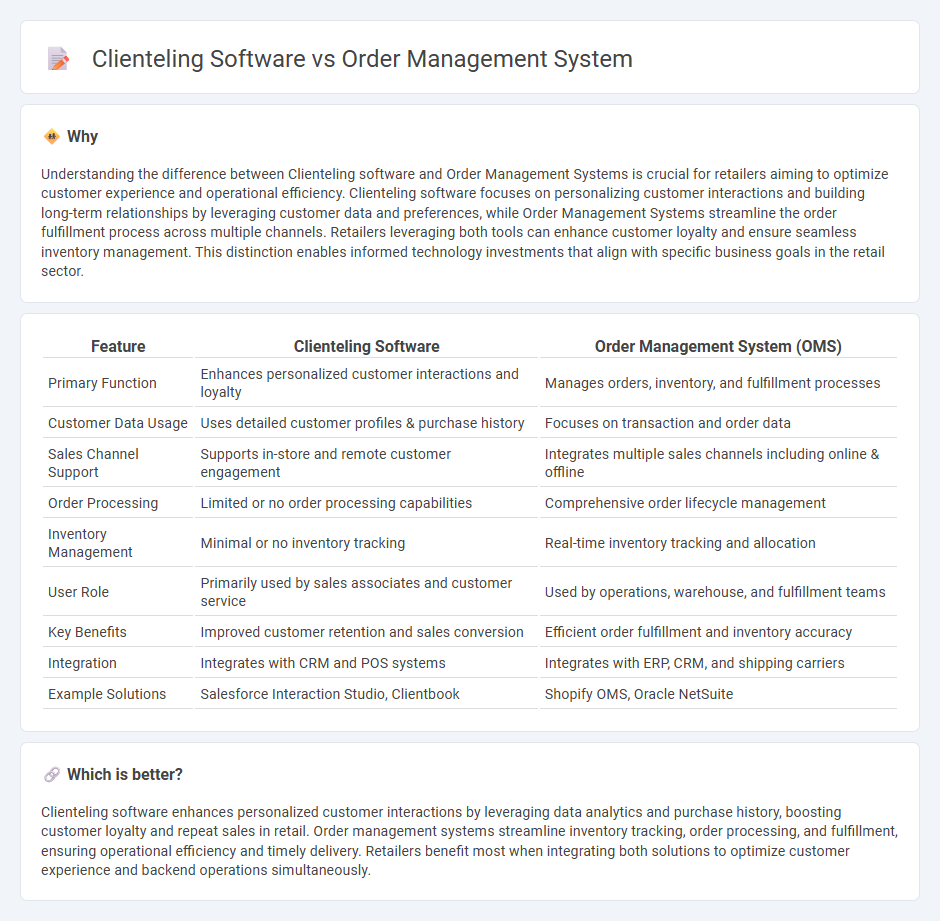
Clienteling software enhances personalized customer interactions by leveraging purchase history and preferences to boost loyalty and sales. Order management systems streamline order processing, inventory tracking, and fulfillment across multiple sales channels for operational efficiency. Explore how integrating both technologies can transform retail business performance.
Why it is important
Understanding the difference between Clienteling software and Order Management Systems is crucial for retailers aiming to optimize customer experience and operational efficiency. Clienteling software focuses on personalizing customer interactions and building long-term relationships by leveraging customer data and preferences, while Order Management Systems streamline the order fulfillment process across multiple channels. Retailers leveraging both tools can enhance customer loyalty and ensure seamless inventory management. This distinction enables informed technology investments that align with specific business goals in the retail sector.
Comparison Table
| Feature | Clienteling Software | Order Management System (OMS) |
|---|---|---|
| Primary Function | Enhances personalized customer interactions and loyalty | Manages orders, inventory, and fulfillment processes |
| Customer Data Usage | Uses detailed customer profiles & purchase history | Focuses on transaction and order data |
| Sales Channel Support | Supports in-store and remote customer engagement | Integrates multiple sales channels including online & offline |
| Order Processing | Limited or no order processing capabilities | Comprehensive order lifecycle management |
| Inventory Management | Minimal or no inventory tracking | Real-time inventory tracking and allocation |
| User Role | Primarily used by sales associates and customer service | Used by operations, warehouse, and fulfillment teams |
| Key Benefits | Improved customer retention and sales conversion | Efficient order fulfillment and inventory accuracy |
| Integration | Integrates with CRM and POS systems | Integrates with ERP, CRM, and shipping carriers |
| Example Solutions | Salesforce Interaction Studio, Clientbook | Shopify OMS, Oracle NetSuite |
Which is better?
Clienteling software enhances personalized customer interactions by leveraging data analytics and purchase history, boosting customer loyalty and repeat sales in retail. Order management systems streamline inventory tracking, order processing, and fulfillment, ensuring operational efficiency and timely delivery. Retailers benefit most when integrating both solutions to optimize customer experience and backend operations simultaneously.
Connection
Clienteling software and Order Management Systems (OMS) work together to enhance retail operations by providing seamless integration between personalized customer interactions and order fulfillment processes. Clienteling software collects and utilizes customer data to create tailored shopping experiences, while the OMS manages inventory, order processing, and delivery logistics, ensuring accurate and timely fulfillment. The synchronization of these systems enables retailers to offer personalized recommendations, track customer preferences, and efficiently manage orders from purchase to delivery, driving customer satisfaction and operational efficiency.
Key Terms
Order management system:
Order management systems streamline the entire order lifecycle by automating order processing, inventory tracking, and shipment coordination, ensuring faster fulfillment and accurate data synchronization across channels. These systems enhance operational efficiency by integrating with ERP and CRM platforms, reducing manual errors and improving real-time visibility into stock levels and delivery status. Explore how an advanced order management system can transform your retail operations and boost customer satisfaction.
Inventory Tracking
Order management systems provide comprehensive inventory tracking by synchronizing stock levels across multiple sales channels in real time, minimizing overselling and stockouts. Clienteling software focuses primarily on enhancing personalized customer interactions but often integrates limited inventory insights tailored to shopper preferences and purchase history. Explore the distinct capabilities and integrations of both systems to optimize your retail operations and customer experience.
Fulfillment
Order management systems (OMS) streamline the fulfillment process by automating inventory tracking, order processing, and shipment coordination, ensuring timely and accurate delivery. Clienteling software enhances fulfillment by providing sales associates with detailed customer purchase history and preferences, enabling personalized product recommendations and tailored service during order completion. Explore how integrating OMS and clienteling software can elevate your fulfillment strategy and improve customer satisfaction.
Source and External Links
What is Order Management? | IBM - An order management system (OMS) is digital software that tracks the complete lifecycle of an order, handling entry, inventory, fulfillment, and after-sales service to provide near real-time visibility for both businesses and customers.
What is an Order Management System? | Salesforce US - An OMS is a software platform that tracks sales, processes orders, manages inventory, and streamlines fulfillment to ensure fast, transparent delivery and simplifies the entire order lifecycle for both sellers and buyers.
Order management system - Wikipedia - An OMS is a computer software system used across various industries for order entry and processing, integrating modules like inventory, vendors, marketing, order processing, customer service, and financial transactions to manage complex workflows and fulfillment.
 dowidth.com
dowidth.com